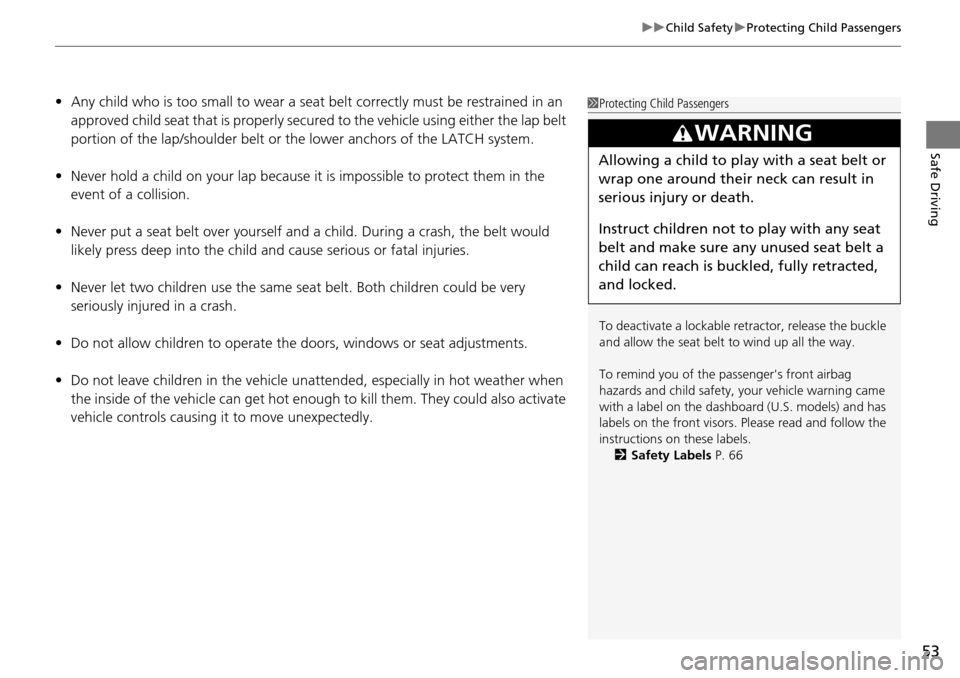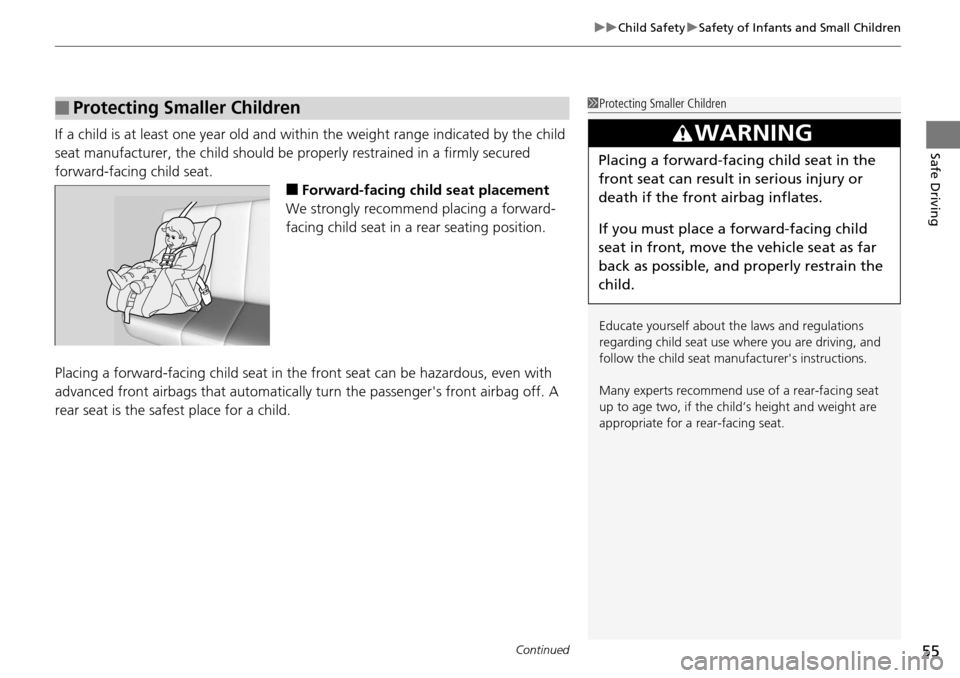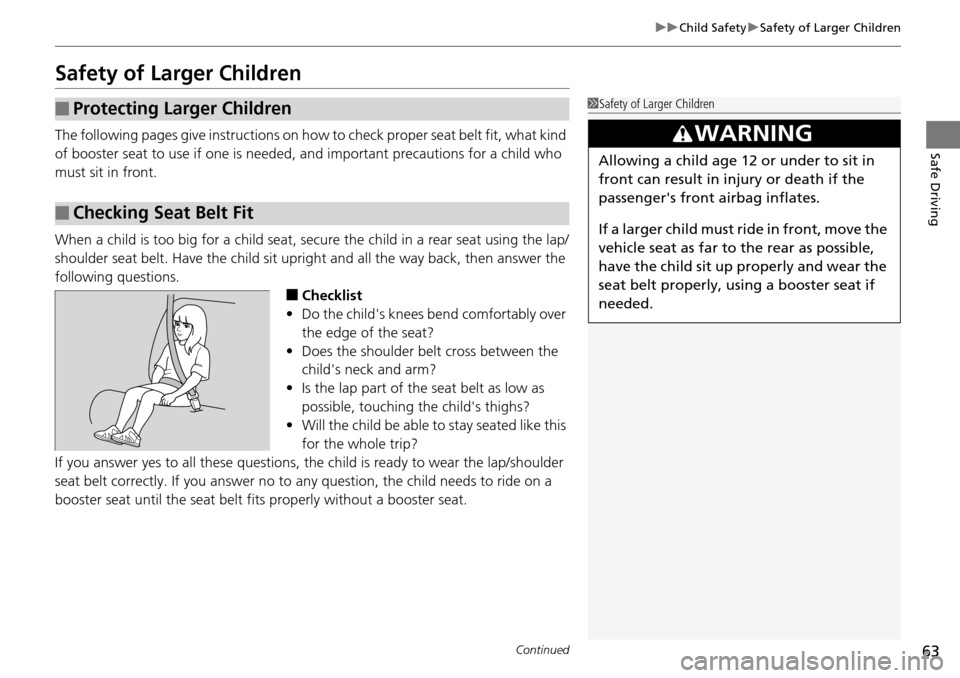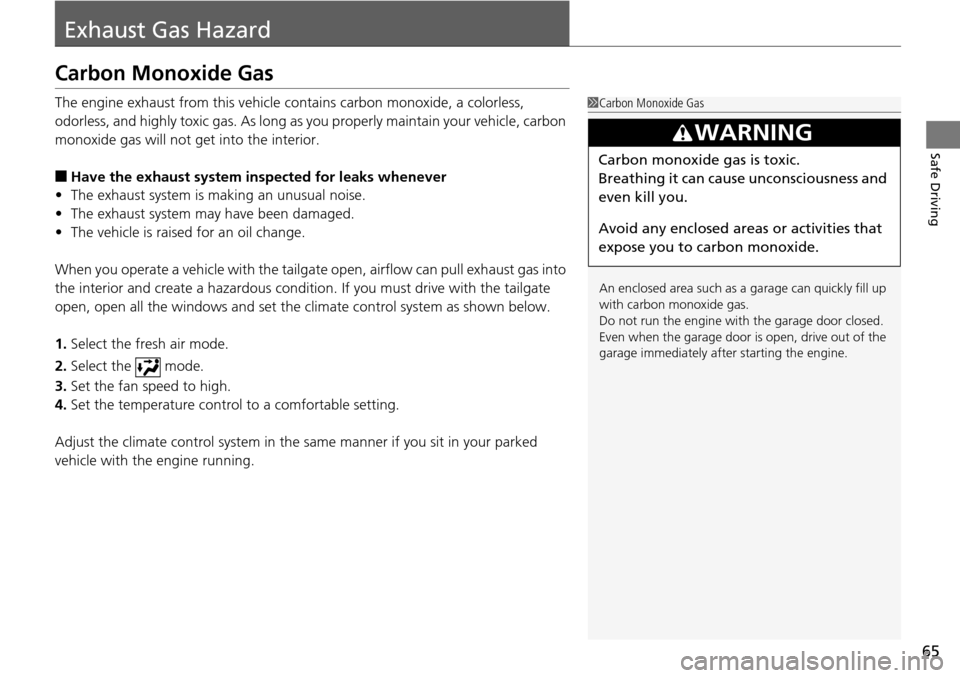2014 HONDA PILOT air con
[x] Cancel search: air conPage 54 of 488

53
uu Child Safety u Protecting Child Passengers
Safe Driving
• Any child who is too small to wear a seat belt correctly must be restrained in an
approved child seat that is properly secured to the vehicle using either the lap belt
portion of the lap/shoulder belt or the lower anchors of the LATCH system.
•Never hold a child on your lap because it is impossible to protect them in the
event of a collision.
• Never put a
seat belt over yourself and a child. During a crash, the belt would
likely press deep into the child and cause serious or fatal injuries.
• Never let
two children use the same seat belt. Both children could be very
seriously injured in a crash.
• Do not allow children
to operate the doors, windows or seat adjustments.
• Do not leav
e children in the vehicle unattended, especially in hot weather when
the inside of the vehicle can get hot enough to kill them. They could also activate
vehicle controls causing it to move unexpectedly.
1 Protecting Child Passengers
To deactivate a lockable retractor, release the buckle
and allow the seat belt to wind up all the way.
To remind you of the pa ssenger's front airbag
hazards and child safety, y our vehicle warning came
with a label on the dashboard (U.S. models) and has
labels on the front visors. Pl ease read and follow the
instructions on these labels.
2 Safety Labels P. 66
3 WARNING
Allowing a child to play with a seat belt or
wrap one around their neck can result in
serious injury or death.
Instruct children not to play with any seat
belt and make sure any unused seat belt a
child can reach is buckled, fully retracted,
and locked.
Page 56 of 488

Continued55
uu Child Safety u Safety of Infants and Small Children
Safe DrivingIf a child is at least one year old and within the weight range indicated by the child
seat manufacturer, the child should be properly restrained in a firmly secured
forward-facing child seat.
■Forward-facing child seat placement
We strongly recommend placing a forward-
fac
ing child seat in a rear seating position.
Placing a forward-facing child seat in th e
front seat can be hazardous, even with
advanced front airbags that automatically turn the passeng er's front airbag off. A
rear seat is the safest place for a child.
■Protecting Smaller Children1 Protecting Smaller Children
Educate yourself about th e laws and regulations
regarding child seat use wh ere you are driving, and
follow the child seat manufacturer's instructions.
Many experts recommend us e of a rear-facing seat
up to age two, if the chil d’s height and weight are
appropriate for a rear-facing seat.
3 WARNING
Placing a forward-facing child seat in the
front seat can result in serious injury or
death if the front airbag inflates.
If you must place a forward-facing child
seat in front, move the vehicle seat as far
back as possible, and properly restrain the
child.
Page 64 of 488

63
uu Child Safety u Safety of Larger Children
Continued
Safe Driving
Safety of Larger Children
The following pages give instructions on ho w to check proper seat belt fit, what kind
of booster seat to use if one is needed, and important precautions for a child who
must sit in front.
When a child is too big for a child
seat, secure the child in a rear seat using the lap/
shoulder seat belt. Have the child sit upri ght and all the way back, then answer the
following questions.
■Checklist
• Do
the child's knees bend comfortably over
the edge of the seat?
• Does the shoulder belt cross between the
ch
ild's neck and arm?
• Is
the lap part of the seat belt as low as
possible, touching the child's thighs?
• Will the child be able to stay
seated like this
for the whole trip?
If you answer yes to all these questions, th e
child is ready to wear the lap/shoulder
seat belt correctly. If you answer no to any question, the child needs to ride on a
booster seat until the seat belt fits properly without a booster seat.
■Protecting Larger Children
■Checking Seat Belt Fit
1 Safety of Larger Children
3 WARNING
Allowing a child age 12 or under to sit in
front can result in injury or death if the
passenger's front airbag inflates.
If a larger child must ri de in front, move the
vehicle seat as far to the rear as possible,
have the child sit up properly and wear the
seat belt properly, using a booster seat if
needed.
Page 66 of 488

65
Safe Driving
Exhaust Gas Hazard
Carbon Monoxide Gas
The engine exhaust from this vehicle contains carbon monoxide, a colorless,
odorless, and highly toxic gas. As long as you properly maintain your vehicle, carbon
monoxide gas will not get into the interior.
■Have the exhaust system in spected for leaks whenever
• The exhaust
system is making an unusual noise.
• The exhaust
system may have been damaged.
• The vehicle
is raised for an oil change.
When you operate a vehicle with the tailga te op
en, airflow can pull exhaust gas into
the interior and create a hazardous conditio n. If you must drive with the tailgate
open, open all the windows and set the climate control system as shown below.
1. Select
the fresh air mode.
2.Select
the mode.
3. Set
the fan speed to high.
4.Set
the temperature control to a comfortable setting.
Adjust the climate control system in the s
ame manner if you sit in your parked
vehicle with the engine running.
1 Carbon Monoxide Gas
An enclosed area such as a garage can quickly fill up
with carbon monoxide gas.
Do not run the engine with the garage door closed.
Even when the garage door is open, drive out of the
garage immediat ely after starting the engine.
3 WARNING
Carbon monoxide gas is toxic.
Breathing it can cause unconsciousness and
even kill you.
Avoid any enclosed areas or activities that
expose you to carbon monoxide.
Page 72 of 488

71
uu Indicators u
Continued
Instrument Panel
IndicatorNameOn/BlinkingExplanationMessage *
ABS (Anti-lock
Brake System)
Indicator
●Comes on for a few seconds when
you turn the igniti on switch to ON
(w
, then goes off.●If it comes on at any other time, there
is a problem with the ABS.
●Stays on constantly - Have the vehicle
checked by
a dealer. With this indicator
on, your vehicle still has normal braking
ability but no an ti-lock function.
2ABS (Anti-lock Brake System) P. 362
Supplemental
Restraint System
Indicator
●Comes on for a few seconds when
you turn the igniti on switch to ON
(w
, then goes off.●Comes on if a problem with any of
the following is detected:
-Supplemental restraint system
- Side air
bag system
-Side curtain
airbag system
-Seat belt tensioner
●Stays on constantly or does not come
on at all
- Have the vehicle checked by a
dealer.
VTM-4 ® System
Indicator *
●Comes on for a few seconds when
you turn the igniti on switch to ON
(w
, then goes off.●Comes on if there is a problem with
the VTM-4 ®.
●Blinks when the VTM-4 ® system is
overheated. The system is inactive.
●Stays on constantly - Have the vehicle
checked by
a dealer.
●Blinks while driving - The VTM-4® fl uid
temperature is too high. Stop in a safe
place, shift to
(P
, and idle the engine
until the indicator goes off. If the
indicator does not stop blinking, take
your vehicle to a dealer.
2 VTM (Variable Torque
Management)-4 r System * P. 354
—
* Not available on all models
Page 75 of 488

74
uu Indicators u
Instrument Panel
IndicatorNameOn/BlinkingExplanationMessage *
TPMS Indicator
●Comes on for a few seconds when
you turn the ignition switch to ON
(w
.●Comes on if there is a problem with
the TPMS, or when a compact spare
tire is temporarily installed.
●Stays on constantly or does not come
on at all
- Have the vehicle checked by a
dealer. If the vehicle is fitted with a
compact spare, get your regular tire
repaired or replaced and put back on
your vehicle as soon as you can.
—
Low Tire
Pressure
Indicator
Low Tire
Pressure/TPMS
Indicator
●Comes on for a few seconds when
you turn the ignition switch to ON
(w
.●Comes on if the tire pressure of any
of the tires becomes significantly low.
●Comes on for a while and then goes
off when a compact spare tire is
temporarily installed.
●Blinks for about one minute, and
then stays on if th ere is a problem
with the TPMS, or when a compact
spare tire is temporarily installed.
●Comes on while driving - Stop in a safe
place,
check tire pressures, and inflate
the tire(s) if necessary.
●Blinks and remains on - Have the
vehicle checked by a d ealer. If the vehicle
is fitted with a compact spare, get your
regular tire repaired or replaced and put
back on your vehicle as soon as you can.
Models with
information
display
Models with
information
display
Models with
multi-
information
display
Models with info rmation display
Models with multi- information display
Models with multi-information display
* Not available on all models
Page 76 of 488

75
uu Indicators u
Continued
Instrument Panel
IndicatorNameOn/BlinkingExplanationMessage *
Turn Signal
Indicators
●The turn signal indi cators blink when
you operate the turn signal lever.
●If you press the hazard warning
button, both indicators and all turn
signals blink at the same time.
●Does not blink or blinks rapidly - A
turn s
ignal light bulb has blown. Change
the bulb immediately.
2 Replacing Light Bulbs P. 404, 405,
406
—
High Beam
Indicator●Comes on when the high beam
headlights are on.——
Lights On
Indicator●Comes on whenever the light switch
is on, or in AUTO when the exterior
lights are on.●If you remove the key from the ignition
switch while the lights are on, a chime
sounds when the driver's door is opened.
—
Fog Light
Indicator *
●Comes on when the fog lights are on.——
Side Airbag Off
Indicator
●Comes on for a few seconds when
you turn the igniti on switch to ON
(w
, then goes off.●Comes on when the passenger side
airbag system is automatically shut
off.
●It does not mean there is a problem with
your side airbags.
●Comes on when nobody is sitting in
the passenger seat - Have the vehicle
checked by
a dealer.
●Comes on when some one is sitting in
the seat
- Have the passenger sit
properly.
U.S.
Canada
* Not available on all models
Page 138 of 488

137Continued
Controls
Adjusting the Seats
Adjusting the Seat Positions
Adjust the driver's seat as far back as possible
while allowing you to ma intain full control of
the vehicle. You should be able to sit upright,
well back in the seat and be able to
adequately press the pedals without leaning
forward, and grip the steering wheel
comfortably. The passenger's seat should be
adjusted in a similar manner, so that it is as far
back from the front airbag in the dashboard
as possible.
■Adjusting th e front power seat(s) *
1Adjusting the Seats
The National Highway Traffic Safety Administration
and Transport Cana da recommend that drivers allow
at least 10 inches (25 cm) between the center of the
steering wheel and the chest.
Always make seat adjustments before driving.
3 WARNING
Sitting too close to a front airbag can result
in serious injury or death if the front
airbags inflate.
Always sit as far back from the front
airbags as possible while maintaining
control of the vehicle.
Move back.
Allow sufficient
space.
Horizontal Position
Adjustment
Height Adjustment
(Driver's seat only) Seat-back Angle
Adjustment Lumbar Support
Adjustment
(Driver's seat
only)
Driver’s seat is
shown.
* Not available on all models